Tulum tour is 10-stop shopping for Mexican souvenirs

FRIDAY, OCT. 24
PLAYA DEL CARMEN, Mexico — Mayans were powerful people. They developed the concept of zero in mathematics. They produced the most accurate calendar in history. They performed mankind’s first brain surgeries. But the most powerful force they showed was peel me off a perfectly good sunny day at the “Biggest Swimming Pool in Latin America.”
I saw an amazing thing yesterday: the sun. I had not seen the sun since I arrived here Sunday. It looked odd. So did the jungle. The green forest seemed to glisten. The birds chirped louder.
So did I.
I took the shuttle from our Grand Luxxe Resort to the adjacent Grand Mayan and hustled through the boutique, somehow managing to not shell out $28 for a bottle of Coppertone. I emerged to see a pool that seemed to stretch all the way to the sea. The Grand Mayan’s pool is a series of rounded swimming areas all formed around little islands sporting palm trees. I frankly could not see the far end of it. But I could hear in the far distance the faint instructions from someone giving aqua aerobics orders through a loudspeaker. The pool could hold a small city around its edge and I maybe saw 10 people. The sun was bright and there was just enough moving cloud cover to give you a break from the heat every 15 minutes.
Unfortunately, we bought into the weather report that it would rain all afternoon. So we signed up for the free Tulum tour that came with putting up with Alvaro’s timeshare spiel for 2 ½ hours. We all piled into a van with a guide named Jak, a smiling, wiry street-smart Mexican with a short beard, earrings and a tattoo of the punk rock band, the Maniacs. Jak grew up in Mexico City but moved to Valencia, Calif., when he was 15. His English had a Mexican accent but he had the swagger of an American with all kinds of inside advice about what to do in Playa.
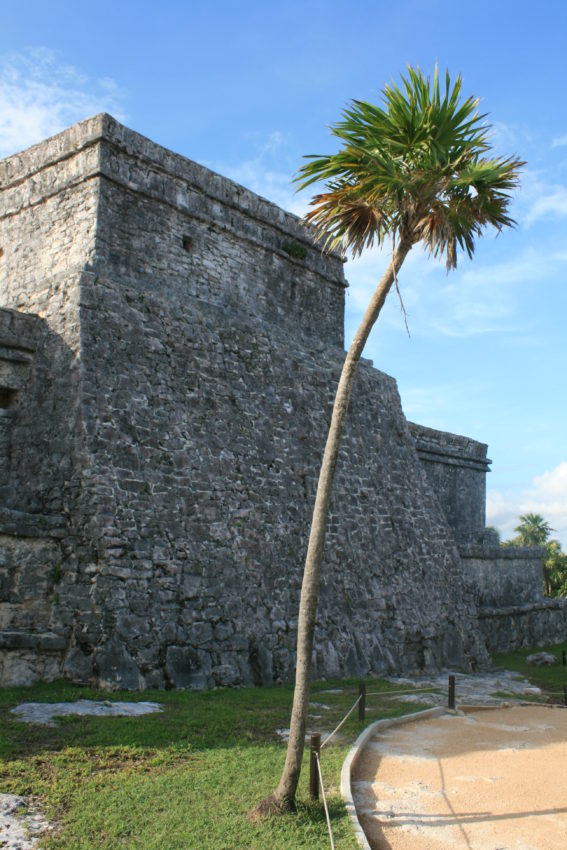
“Go to Fifth Avenue,” he said. “There’s always something going on.”
He gave us a recommendation for Alux, one of two restaurants in the world served inside a network of caves.
“Every time I’ve taken a date there,” he said with a wry smile, “it worked.”
Sitting in front of us was an odd couple. The guy was a heavily muscled, heavily tattooed blond laborer with a strange accent. It’s found in that one area of New Hampshire — er, New Hempsheh — where they don’t include R’s in the alphabet. The only thing I could tell about it was he spoke in terrible grammar as if he was a career laborer. But he was all over a lumpy blonde woman with tired eyes who looked liked his mother. From the time we saw them at the bus stop to the time we were dropped off seven hours later, they were drinking Coronas. They brought them in the van, bought them in souvenir stores, bought them in the restaurant at the end of the day. I don’t know how they could even stand. My frat days are over. If I drank three beers in the middle of the afternoon I’d be asleep under a palm tree by 3 p.m.
The tour was only worth it if it was free. I noticed on the ticket the usual charge is $59. They should’ve paid us half that just for the first part. They took us straight to a jewelry store in what no doubt would be labeled in most Western countries as a hostage situation. Lapis is a gargantuan jewelry factory on the main highway. It’s a big orange building with little Mexicans working behind a glass panel. They had little sharp needles they used to grind into whatever silver object they had in their hands.
Lapis is totally high end and as big as some small airplane hangars. It was all shiny black with back-lit display cases of jewelry on snow-white stands. It has 60,000 pieces of silver, none of which I could afford. Maybe they don’t realize that just because you’re a timeshare owner doesn’t mean you’re rich enough to afford $5,000 watches. Or some, like me, are there free. Half my watches are $5-$10 costume watches found in French flea markets and dive Vegas strip malls.
They had some beautiful pieces, though. Rubies. Diamonds of every color. Gold. Emeralds. Every one was shined like stars behind the glass. I saw a case of beautiful hand-carved Mayan masks. I asked the price.
It was $790. “But,” the clerk in the sharp black suit said, “with today’s discount it’s $490.”
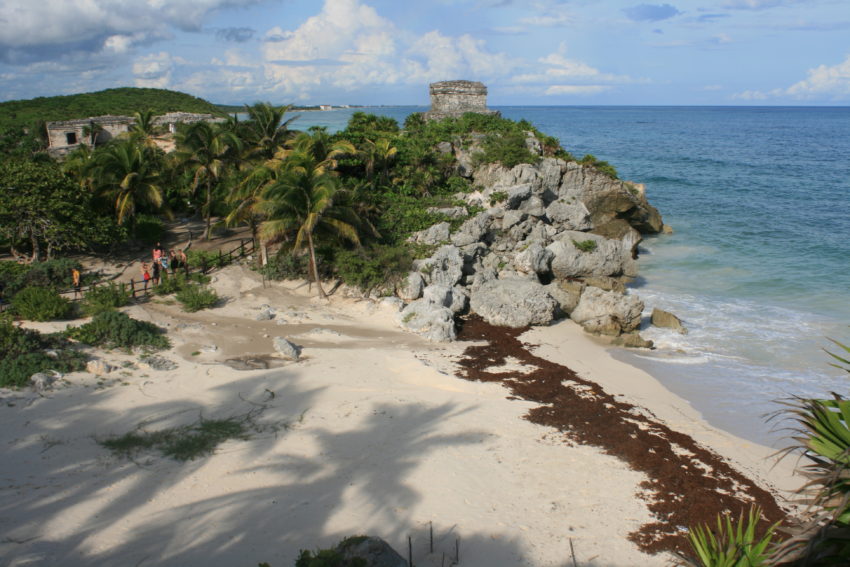
Luckily, the only other item I liked was one I could afford. I saw a jet-black watch with shiny gold interior. I figured it was real gold. It was only stainless steel. Price: $45. I bought it. No man in Rome can have enough watches.
Tulum isn’t what I expected. A couple years ago I went to Ek-Balam, a former seat of the Mayan kingdom north of here. That featured everything from living quarters to warehouses to an acropolis. Even though Ek-Balam’s influence faded later during the empire, I got a feel for what the complexity of a major Mayan city.
At Tulum, the first thing we saw as we pulled into a parking lot was a souvenir emporium the size of Wal-Mart. Is there a country that has more souvenirs than Mexico? This place makes Rome look like a fishing village in Greenland. Mexico seems to have as many different brands of tequila as dirty T-shirt messages.
We disgorged out the back of the store to a string of smaller souvenir stands, each one with a barker telling us we can not survive any longer without a hand-carved Mayan paperweight. I told one merchant, holding up what looked like an op-art wood project by an artist on peyote, “I have one.”
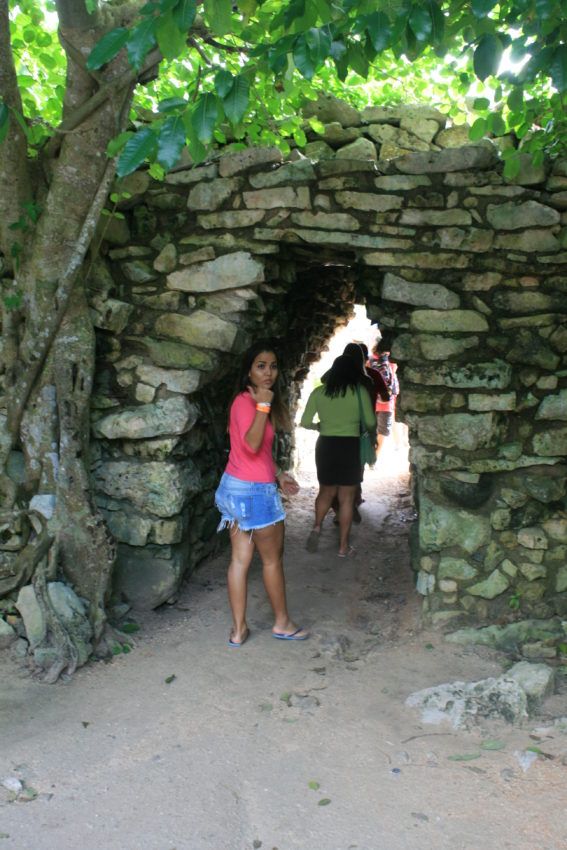
Not missing a beat, he said, “Have another one.”
We then boarded a crude wooden train with an engine and one car and chugged up the track to the outside of the Tulum wall. Our guide was a tall, dark, late 30ish gent with the perfect haircut and a crisp white shirt, shocking in the searing humidity. What proceeded was the shortest tour I’ve ever been on. It lasted all of 15 minutes. The guide spoke only four times. Outside the wall he explained to us that Tulum thrived between 1200-1500 AD. Tulum is a Mayan word for “Walled City” and inside the walls were the community’s wealthy. Outside the walls were the working class, not too similar from how European cities are designed today. About 500 people lived inside and 5,000 outside, that is, until the Spanish came and baptized the Mayans in their own blood,
As soon as we ducked our heads under the small door frame and walked inside, the teetering New Hampshire couple poured themselves off the tour, presumably hoping some Mayan beer stand was open somewhere.
“This place looks like a golf course with rocks,” said the woman.
I was about the only one who hung around. Everyone else took selfies in front of ruins, the importance of which they had no idea. What little the guide said was pretty good. He pointed out one stone temple sporting one window. He said every March 21, the sun is just right. When it shines in the window, a star appears. He even showed a picture of it from seven months ago. The Mayans used this as a sign that the spring raining season was coming, one reason why the Mayans are credited with developing mankind’s first credible calendar.
The ruins are fairly well preserved. On some ruins, you can still see red hand prints from the artist who painted the building. Mayan gods’ faces are still recognizable in carvings on the corners of the temples.
What makes Tulum is the main temple. It’s a short pyramid but what interested me were two flat stones about three feet high. Here is where they held human sacrifices but it wasn’t a quick death. They opened up the chest and took out the heart, sometimes still beating. And they weren’t virgins or prisoners of war.
“They were the best of the best,” the guide said. “The best artist, the best player, the best dancer. They wanted to sacrifice the best to get the best from the gods.”
“Surely,” my friend quipped to me, “you would’ve survived.”
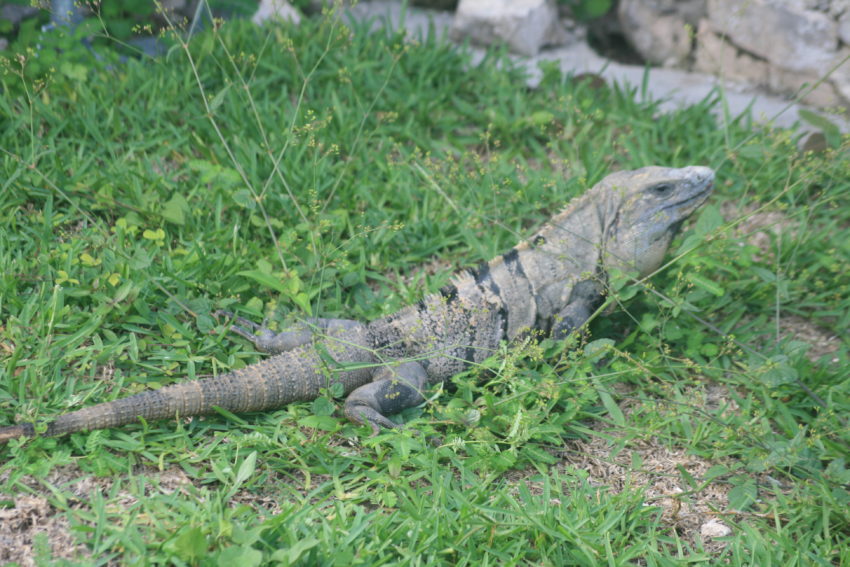
After our guide rejected my request to drag said friend atop the temple, he indicated that the Spanish didn’t understand the Mayans at all. As Catholics, they knew snakes represented Satan from the Bible. What did they think when they came to Tulum and saw references of snakes all over the city? They’re on temples, homes. The snake was the main god of the Mayans which the Spanish didn’t consider as they held book burnings all over Yucatan.
Behind the temple is a cliff looking down at one of the best beaches in the region. It’s an enclosed cove lapped up by a beautiful blue ocean. But, alas, that’s where turtles lay their eggs and it’s off limits. Instead, tourists climb down about five flights of wooden steps and swim on a small beach with a big yellow rope marking off the dangerous areas. The view was breathtaking. You can see why the wealthy lived here. Life in Mexico hasn’t changed much. It’s still location, location, location.
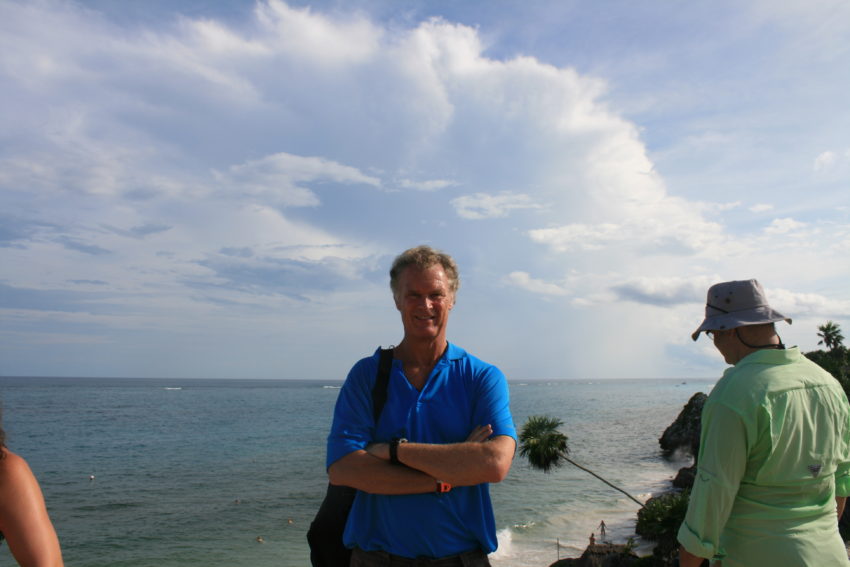
I wonder if it was this hot. My clothes were soaked and so was my brain for coming on this tour when I could be soaking by the pool. When we finally got back, however, the little golf cart driver said, as he whisked through the wet walkway, it had rained all afternoon.
Meanwhile, the New Hampshire woman was crying at the adjacent Mayan Palace Resort after she left her iPad on the bus.
“After that stupid Tulum tour I lost my iPad!” she said before breaking down in tears. Maybe some Mayan gods are still around.


November 12, 2014 @ 9:59 am
Oh boy, that’s one side of Tulum that luckily I have not experienced. Yeah, Tulum has grown quite a lot in the past ten years. In fact I see a lot of changes each time I go there. But so far no high rises are allowed. Apparently they “learned” from Cancun what not to do. Sure cabanas there use to be $10 bucks a night and now they are $150. But still, at least the cabana style is maintained. And if you spend some time at one of the simple but charming cabanas on the long stretch of beach south that is a few miles south of the archeological site, you will be very removed from tour buses and tourists who can only handle “all inclusives.” You will find a slow pace, big Mayan smiles, and bohemian travelers who are apt to be French and Italian. There are some very good restaurants now too in Tulum’s simple pueblo, which are far cheaper than the ones on the beach, where I’ve had truly wonderful meals at a very decent price. I love Tulum. It is in fact my favorite place outside of Italy, but perhaps you have to dig a bit more now to find its magic. Next time you go, contact me and I’ll give you the scoop on where to stay and where to go!